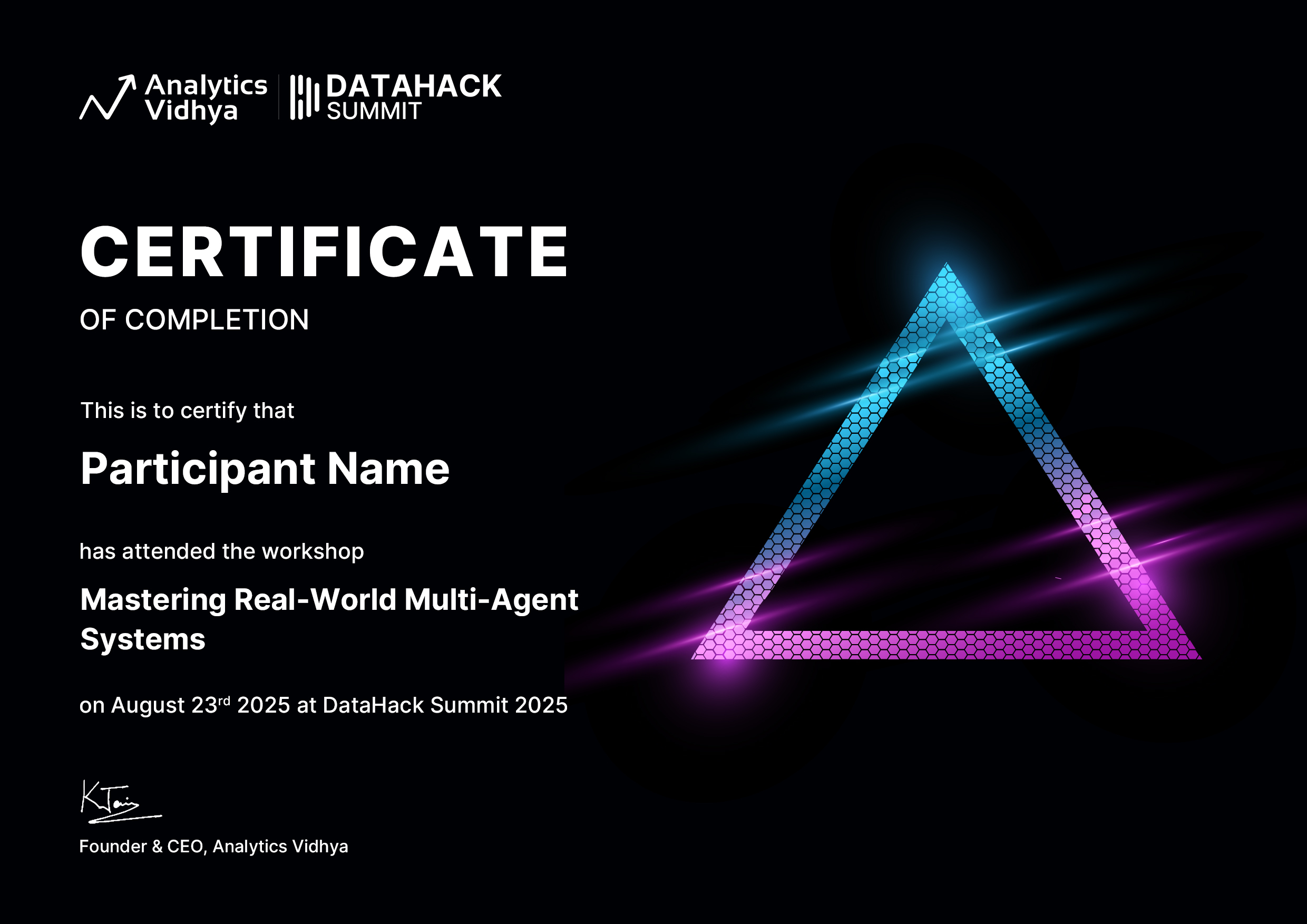Mastering Real-World Multi-Agent Systems
23 August 2025 | 09:30AM - 05:30PM | RENAISSANCE :- Race Course Rd, Madhava Nagar Extension
About the workshop
In this hands-on technical workshop, we’ll explore multi-agent orchestration using CrewAI, diving into how autonomous agents can collaborate to solve complex problems. You’ll learn how to define, configure, and coordinate agents using CrewAI’s core components, all in Python.
We’ll walk through the main classes of problems this approach is suited for and guide you step by step through building real-world workflows. Topics include agent creation, orchestration strategies, tool integration (including custom tools), and LLM-agnostic setups. We’ll also look at how to connect CrewAI with external libraries such as Streamlit to bring your solutions to life.
What You’ll Learn:
- How to define agents and tasks in CrewAI
- Coordinating agents through orchestration flows
- Using and creating tools and custom tools
- Working with different LLMs (LLM-agnostic setups)
- Integrating with libraries like Streamlit
- Best practices for building maintainable and scalable agent systems
Prerequisites:
- Basic Python knowledge (e.g., installing packages, creating environments, defining classes)
- Please come prepared with:
- An OpenAI API key (or another LLM provider)
- A Serper.dev API key
*Note: These are tentative details and are subject to change.

Modules
Kick off the workshop with a clear overview of what CrewAI is and why it's a game-changer in the realm of agent-based systems. We'll discuss the motivation behind multi-agent orchestration, walk through CrewAI’s core and advanced components (agents, tasks, tools, crews, flows), and map these to real-world business use cases such as content generation, fraud detection, customer service, and onboarding. You’ll also get an outline of the workshop structure and what to expect in each module.
- Why multi-agent systems?
- Core components: agents, tasks, crews, tools, flows
- Advanced features: conditional logic, async orchestration, LLM-agnostic setups
- Business case examples and architectural patterns
In this hands-on session, you’ll set up your environment and build your very first CrewAI application. Learn by doing: define a basic agent, assign it a task, and compose a simple crew. This module ensures all participants are equipped with working installations and a clear understanding of the basics.
- Environment setup (virtualenv/conda, dependencies)
- Installing and configuring CrewAI
- Creating your first agent and task
- Forming your first crew and running a workflow
Here, you'll build a content creation application using agents and flows, with built-in "guardrails" for maintaining quality, relevance, or tone. Learn how to define conditional orchestration strategies to guide the process across multiple agents, each responsible for different steps in content generation.
- Using flow for conditional task execution
- Implementing content generation with validation steps
- Guardrails through intermediate agents
- Real-world use case: blog/social media content generation
Design a fraud detection pipeline using agents trained to analyze transaction logs and behaviors. This scenario introduces a more data-driven approach, integrating tools and heuristics for pattern recognition and classification.
- Parsing and structuring transaction data
- Agents for anomaly detection and classification
- Using external tools (e.g., regex, statistical tests)
- Workflow coordination and response generation
Create an AI-powered onboarding system that adapts to users through personalized interactions. Leverage persistent memory (via mem0) to build context-aware conversations across sessions and allow agents to learn and recall user preferences.
- Designing agent memory with mem0
- Personalized task flow for onboarding
- Integration with user input tools (forms, questionnaires)
- Memory persistence strategies for long-term agent behavior
Wrap up the workshop with a capstone project: a multi-agent interview simulator with Streamlit. This end-to-end application connects CrewAI agents to a front-end UI and includes voice-to-text and text-to-speech capabilities for a seamless conversational experience. This module ties together everything learned so far and provides a production-style template for real-world applications.
- Creating an interactive front-end with Streamlit
- Setting up voice interfaces (text-to-speech, speech-to-text)
- Orchestrating a crew for mock interviews
- Connecting UI, tools, and CrewAI agents into a coherent system
Instructor
Certificate of Completion
Receive a digital (blockchain-enabled) and physical certificate to showcase your accomplishment to the world
- Earn your certificate
- Share your achievement


